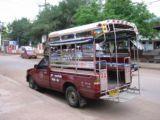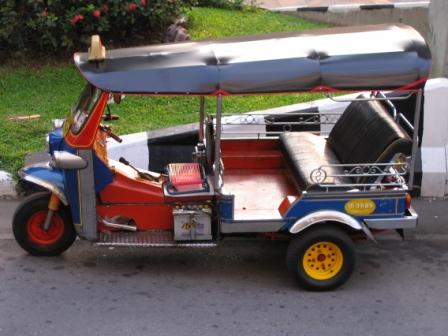
Тайландски живот
Стил на живот
Thai transport

The Thai transport is so different. Buses are a major method
of transportation for people and packages, and the most popular means of long
distance travel.
A songthaew (สองแถว-literally "two rows") also known in English as a baht bus,
is a passenger vehicle in Thailand adapted from a pick-up or a larger truck. It
takes its name from the two bench seats fixed along either side of the back of
the truck; in some vehicles a third bench is put down the middle of the seating
area. Vehicles on longer routes may be converted from larger trucks for about 40
passengers. Some vehicles have roofs large enough to accommodate standing
passengers within the vehicle, or passengers may stand on a platform attached to
the rear.
รักเธอ ประเทศไทย
Tuk tuk (ตุ๊กตุ๊ก)
Tuk Tuk also know as a Samlor, this is a little 3 wheeled monster in
green (in Bangkok) or in different colors (in country) doing a similar job
to the taxi. They remind me of the style of a 2nd WW aero plane mixed with a
locomotive, and throw a helicopter like Three wheeled Thai Airline. They are
occasionally faster than taxis in heavy traffic as weaving in and out is
easier, but generally about the same or slower. As tuk-tuks are open-ended,
they expose passengers to the high pollution levels in the middle of
Bangkok's roads and offer almost no protection in case of an accident. There
is theoretically a ban on new tuk-tuks as they are so noisy and polluting,
but it doesn't really seem to be being enforced at present. Fares always
have to be bargained for, and it is sometimes possible to bargain tuk-tuk
drivers down to less than the taxi flag fall of 35B when they make good
value. But for farangs the price start from 200B so you have to be careful,
it's essential to bargain the price with tuk-tuks before getting in. If you
only ask after the ride, it's likely to end in a request for an ridiculous
fare which can obviously lead to an unpleasant situation. Just like taxi
drivers, the tuk-tuk drivers mostly come from the rural northeast of
Thailand and don't have to undergo any training (some will not even have
passed a driving test), so don't be surprised if they sometimes have no idea
where your destination is. A subtle point to remember when in one is not to
rest your feet on the rail near the drivers head, as doing so is extremely
disrespectful towards the driver.
Some of these Thailand green monsters are so loud, so 2 stroke-y, crack’n
and popping everyone’s eardrums, it’s absolute madness. Uhuh. Just another
day in Thailand, and everyone just accepts it… like I said, that’s Thailand
lifestyle for you… accepting…
The easiest and most comfortable way to get around, if not always the
quickest, is by the aircon taxi. These come in quite a few different
colors though the green-yellow and red-blue ones are the most common. Bangkok
has thousands of taxis, and finding one at any time is never a problem. The
occasional exception to this is during a monsoon season downpour. By
international standards they're very cheap too, the flag fall rate is 35B (0.85
US$ approx) including the first 2km and it's 5B/km after that. This means that
even relatively long journeys, such as from Sukhumvit to the Grand Palace often
aren't above 100B (2.5 US$). A surcharge is applied in traffic jams (1.25B/m
when moving under 6km/h), meaning at night when there's not much traffic they're
definitely the best way of getting around.
The two tone green and yellow taxis are generally reckoned to be the best ones.
These are driven by the owner, while all others are rented out by the day.
If you aren't near any taxis, you can phone 1661 and order one to pick you up.
This costs the meter fee + 20B.
The sky train system is generally very popular with visitors staying near its
stations. It makes travelling long distances substantially quicker than by road
and is relatively inexpensive. Inside, it's clean and air-conditioned, and
certainly compares very well to the mass transit systems elsewhere in the world.
How to travel in Thailand
The best way is with bus because is cheap, with air-condition and good service. If you go to south or north Thailand you can choice and domestic air service, or train with sleeping coach which also have air-condition. In Bangkok the best way is with taxi, also sky train or metro. With Tuk Tuk have to be careful when you bargain for the price. The motorcycle taxi drivers, but they're not adverse to tourists using their services either of course. Unlike taxis and tuk-tuks, the motorcycle taxi drivers will usually not cruise around looking for passengers but gather in groups at various 'stations' (win motor-sai in Thai) around the city.The drivers are easily recognisable by the red jackets or orange jackets they wear, on which are written (in Thai only) the station they work from and their number. To use one, simply walk up and state your destination and make sure to agree the price with the driver first. A motorcycle taxi driver will generally return to his station after delivering you to your destination, so he has to figure the return journey into the price too. Helmets are a legal requirement for riding on a motorbike in Bangkok and should always be provided by the driver, but this is not always the case. It's worth insisting on one, as if caught by the police without one you face a 200B - 500B fine. It's unlikely the helemt you will be given could be relied on to give more than token protection in the event of a crash however. An additional substantial risk is of passengers unexpectedly getting out of cars (usually taxis) without seeing a motorbike which is overtaking it on the inside. At the speed the drivers like to travel, any kind of accident could easily be very serious and if you are injured you may simply be picked up and hauled off to hospital on a passing tuk-tuk with little regard for any injuries sustained.
Bangkok
Formerly known as the 'Venice of the East', Bangkok still has an excess of waterways that offer a great way of getting around. River express and canal boats regularly ply several routes unaffected by the constant traffic on the roads, and are very cheap too. The boats are long, fast, and normally colored white with a red stripe. Fares vary slightly according to the destination, they're between 5B and 10B. Boats seem to come around every 20 minutes, start at 5.30am and the last boat leaves each end at 6pm.
Thai resources
- Тай история
- Тай природа
- Тай кухня
- Тай плодове
- Тай жени
- Тай пътуване
- Тай транспорт
- Тай-Българска връзка
- Форум
Facts
The fact that almost every guidebook on Thailand says they "drive on the left - most of the time" gives some idea of the general driving standard, too. It could never be said though, that Bangkok lacks options for getting around - with a range of taxis, tuk-tuks, canal boats, river boats, the skytrain and an extensive bus system. With a bit of knowledge about all of the choices, it is definitely possible to get around easily, cheaply and even quickly.

